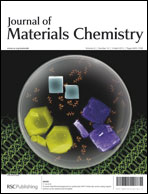Synthesis, optical and ferroelectric properties of PZT thin films: experimental and theoretical investigation
Abstract
PbZr0.40Ti0.60O3 (PZT40/60) thin films with ferroelectric and dielectric properties have been grown on Pt/Ti/SiO2/Si and LaAlO3 (100) substrates using the chemical solution deposition method. These films have been characterized by different techniques such as


 Please wait while we load your content...
Please wait while we load your content...